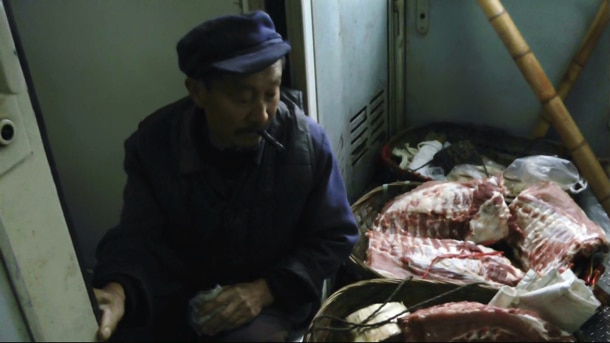





Dir: J.P. Sniadecki | China/USA Documentary 82mins
You could be forgiven for thinking there’s a projection fault at the start of THE IRON MINISTRY, as brooding, bassy railyard hums meld over an appreciably sustained stretch of black screen, with the high-pitched screeches of trains coming to a halt. The resulting landscape, though evoked entirely through sound, is vividly panoramic—so it comes as something of a surprise when the first images proper of the film appear to be so disorientingly and claustrophobically abstract. J.P. Sniadecki’s latest documentary is a typically immersive work, and receives its world premiere this week in the 67th Locarno Film Festival’s International Competition.
With works like DEMOLITION (2008), THE YELLOW BANK (2010) and PEOPLE’S PARK (2012), Sniadecki had already proven himself to be a key member of Harvard’s Sensory Ethnography Lab. Though his co-directed documentary FOREIGN PARTS (2010) focused on an area of Queens, New York, the director’s body of work is growing into a committed and often compelling portrait of contemporary China, as witnessed and experienced by at a ground level perspective. The latest addition to this ongoing project was shot over the course of three years (2011-13) on the country’s vast rail network, soon to be the largest in the world.
THE IRON MINISTRY begins with the finer details—close-ups of rubber inter-carriage gangways, cigarette butts, raw slabs of beef and mutton—before allowing its many characters to emerge fleetingly from the chaos. Chaos is about right: overstuffed with families, workers, students and migrants, these passenger trains are a microcosm of human activity. Sniadecki’s camera negotiates its way through the carriages surveying what it can, proceeding at knee-height and at head-height, panning left and right to take in the crowd. Sometimes, it stops in the vestibules to absorb a conversation between smokers, or between two women in a Bechdel-passing chat about low wages, longer hours and rising prices.
On a sleeper train, one young lad ironic beyond his years welcomes everyone aboard from his top bunk, claiming that explosives are welcome and that, because it’s a civil train, pissing and shitting is encouraged. Extending limbs and heads out of the window, he quips, can help passengers contribute to China’s population control measures. On another train, the filming crew is prevented from entering a visibly less populated first-class carriage. Not long after, we hear the surreal diegetic sound of an instrumental rendition of the TITANIC theme tune mingling with the cacophonously ubiquitous drones of the train itself rattling along.
This music—presumably coincidental—is uncanny. Though the class divisions in James Cameron’s 1997 crowd-pleasing epic may have been milked for dramatic purpose, they remain militantly upheld across the world, not least of all in China, the mammoth embodiment of transglobal exploitation. Indeed, watching this film makes the flashily fanciful allegories of Bong Joon-ho’s SNOWPIERCER look decidedly less fantastical than they first seemed. The future is already here.
So, what of it? What, indeed, do we make of the many complaints, anxieties, desires and dreams expressed here, by the young and by the old, by the shoeshines and other quick-buck hopefuls? While Sniadecki’s access-all-areas approach is commendable, the anything-goes feel seems to be a matter of editorial indiscipline rather than of premeditation. One always feels that a documentary of this ilk could be three hours long or three minutes long, and the variation in canvas size wouldn’t impact our overall understanding of the content therein. It’s one thing to gain access to a social snapshot like this, but—just as a zoomed-in shot of the passing landscape outside suggests China is a patchwork quilt that denies easy comprehension—at a certain point, one must ask to what extent the artist is intervening upon matters.
At a stretch, one could argue that merely presenting recorded material is not necessarily the same as creating a picture from it. Though Sniadecki in this sense is a stronger artist than Wang Bing, his evident talent and previous achievements suggest that now might be the time to go beyond an ethnographical account and make something truly ambitious, hitting and more explicitly probing. MICHAEL PATTISON